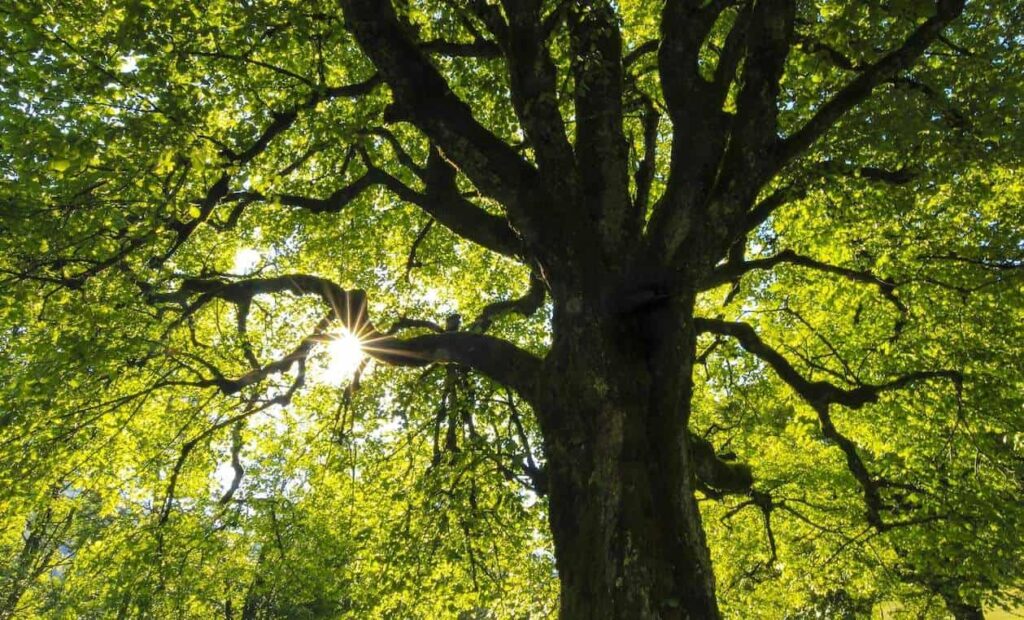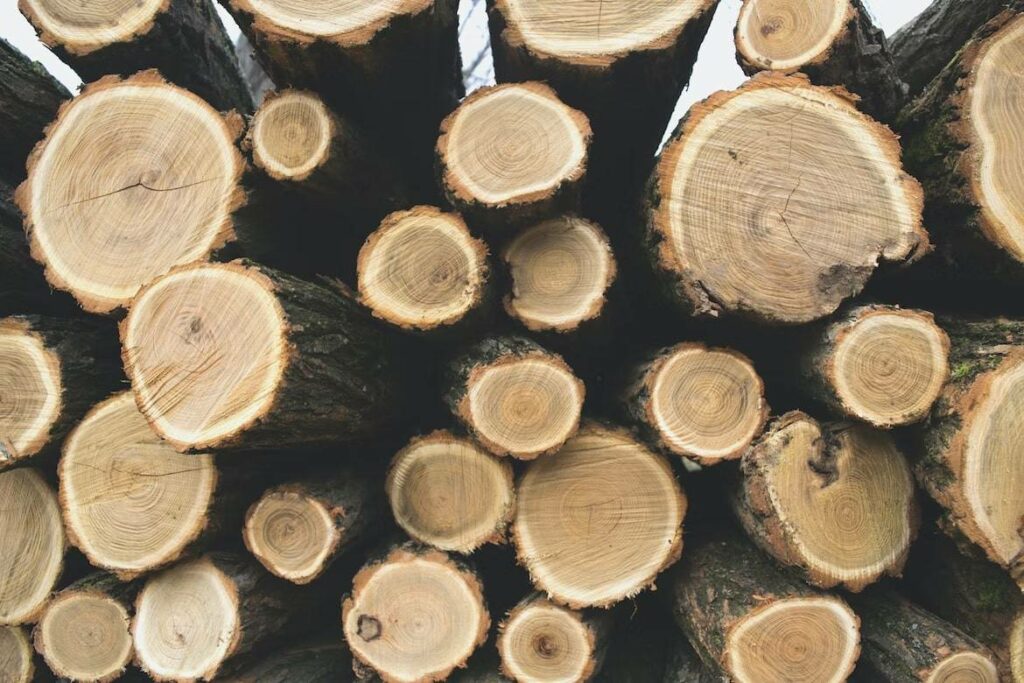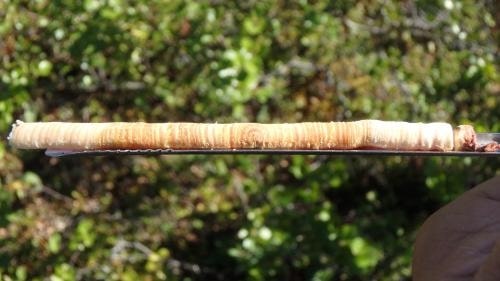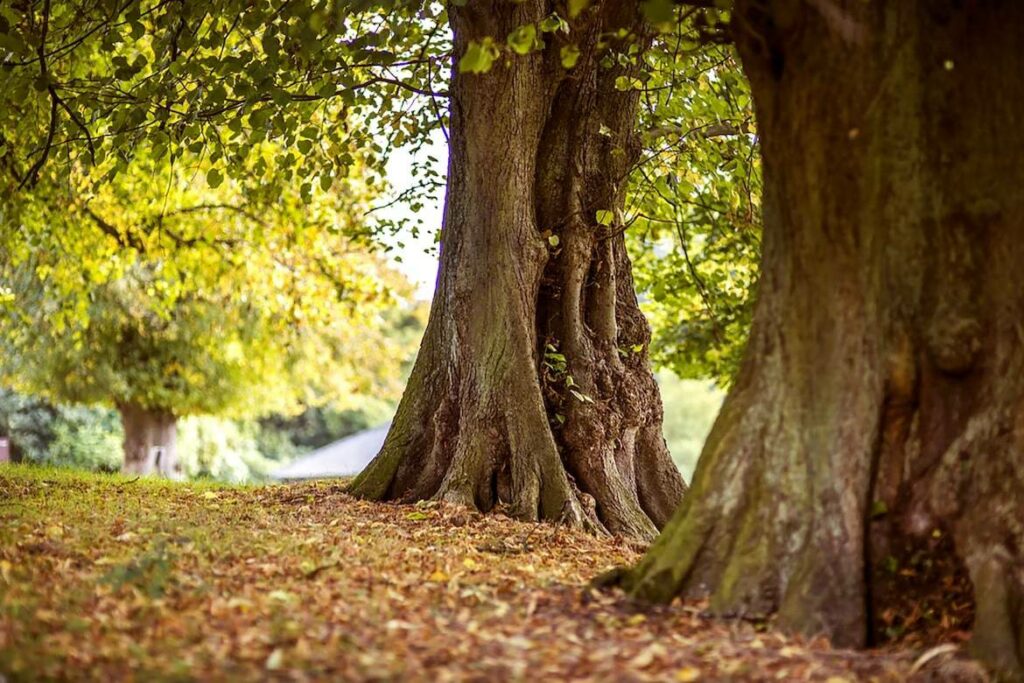
If you’re curious to find out how old your tree is, there are several easy ways to tell! From measuring the circumference of the trunk to counting the interior rings, there’s definitely a method for different types of trees.
How can I tell how old a tree is?
You can tell how old your tree is by counting the interior rings.
But while this is the most popular and accurate method, it’ll require you to chop down the tree.
Alternative methods include:
- Counting the rings through a core sample
- Counting the branch whorls
- Multiplying its diameter by its growth factor
- Measuring the trunk’s girth
Let’s look at these methods one by one.
1. Counting Interior Rings on the Trunk

To count the interior rings, you’ll need to either find a tree stump or the cross-section of wood that’s nearest to the stump and has a visible ring pattern.
Simply count both the alternating light and dark-colored rings to calculate the tree’s age. Each ring marks the passing of one year.
Counting the interior rings on the trunk of your tree is arguably the most common and accurate method of determining your tree’s age.
This is because trees typically grow two new sets of rings annually – one produced in spring and the other in late summer or early fall.
Even then, there could be instances wherein deviations may occur due to unusually warmer temperatures, damage, or drought.
Hence, the tree could produce additional or fake growth rings. It’s also possible to observe absent or blurry interior rings.
How To Do It
- Find a tree stump or horizontally cut the cross-section of the tree nearest to the stump. You’ll need to be able to visibly see the tree’s ring pattern.
- Count the rings on the stump carefully.
The newest rings are those located nearest the bark and are typically lighter in color.
Meanwhile, the oldest rings are at the center and often called the “heartwood”. They’re usually darker in color, which is sometimes an indication that they have begun to rot.
However, this technique will require you to cut down your tree horizontally. This way, you’ll be given a flat stump with a clear view of the tree’s rings.
Hence, this method is only recommended if you already plan to take down the tree or if it has fallen.
It’s also worth noting that some species of trees don’t have easily visible interior rings. In particular, some tropical trees don’t produce growth rings since they develop throughout the year.
2. Counting Interior Rings on a Core Sample

Another way to count interior rings is to use an increment borer to take a small core sample to count from there.
An increment borer is a T-shaped instrument that’s used to manually drill in a small hole in and out of the tree. They’re normally found in the forestry or gardening section at stores.
While similar to the previous method, this technique doesn’t require killing a tree.
What To Do
- Position the increment borer at about 4 ½ ft from the tree’s base.
- Hold the tip of the increment borer onto the base of the trunk while steadily clutching the handle at about chest height.
- To drill, apply steady and firm pressure onto the increment borer while moving the handle clockwise. Continuously drill until you’ve reached about 2 to 3 inches past the middle of the trunk.
To determine how much distance you’ll need to drill before you reach the center of the tree, you’ll need to calculate its radius.
You’ll first need to calculate the diameter. To do so, divide the circumference of the tree by pi (about 3.14).
Afterwards, divide the diameter by 2 to determine the radius. The answer will give you an idea of how far you’ll need to drill to reach the center of the tree.
- Once you’ve reached your desired depth, carefully insert the extractor into the augur. Then, continuously turn the handles clockwise to remove the entire increment borer.
After successfully removing the increment borer, you’ll have a core sample with visible curved lines, which are the tree’s growth rings.
To find the center of the trunk, look for a dot located at the opposite end of the bark. If you have trouble locating it, you may have not drilled deep enough.
If the rings aren’t prominent, you can sand the wood starting with 60-grit sandpaper. Subsequently, finish up with 400-grit sandpaper.
Alternatively, you can lay the core sample on a large sheet to extend the lines. You can also use a magnifying glass to help you better make out the concentric rings.
3. Counting the Branch Whorls

Counting the branch whorls to tell how old a tree is only applies to species such as conifers and evergreens, because their branches develop in rows circling the tree in regular growth patterns.
Hence, it’ll be easier for you to count each ring precisely in comparison to broadleaf trees that produce branches irregularly.
What To Do
- Starting from the base of the tree, identify the branches that are growing at similar heights.
Don’t forget to check the bottom of the tree behind the nearest set of branches for stubs or knobs. A row of these can be counted as additional whorls.
- Once you’ve gotten a general idea of each row of branches, begin counting starting from the lowest row of whorls until the top.
It’s important to note that you may come across irregular branches. In other words, individual shoots that have grown between whorls.
Irregular branches are typically a result of an injury or atypical environmental circumstances. Hence, these shoots aren’t counted.
- After you’ve counted all of the whorls, add 2 to 4 years. This takes into consideration the period it took for the seedling to germinate and grow before it began developing branches.
For example, if the total number of whorls were 10, add 2 to 4 years to get the estimated age of your tree. With that said, your tree should be around 12 to 14 years old.
4. Estimating based on Growth Factor

Estimating your tree’s age based on its growth factor involves measuring the trunk’s circumference and multiplying the girth measurement by the tree type’s growth rate.
This method takes into account the rate of growth depending on what kind of tree it is.
What To Do
- Get the circumference or girth of the trunk. This may depend on the type of landform that your tree is standing on.
| Landform | Height of Measurement |
| Flat | 1.4 meters or 4 ½ feet from the ground |
| Sloped | Mark 1.4 meters or 4 ½ ft from the ground on the uphill and downhill side then get the average to locate the midpoint |
| Forked at a height of less than 1.4 meters or 4 ½ ft from the ground | Height of the trunk right below the fork |
- With the circumference, calculate for the diameter. To do this, divide the circumference by pi or 3.14.
- Multiply the diameter by the tree type’s growth factor to determine its estimated age.
Here are the growth factor rates for different tree species:
| Tree Type | Growth Factor |
| Red Maple | 4.5 |
| Silver Maple | 3.0 |
| Sugar Maple | 5.5 |
| River Birch | 3.5 |
| White Birch | 5.0 |
| Shagbark Hickory | 7.5 |
| Green Ash | 4.0 |
| Black Walnut | 4.5 |
| Black Cherry | 5.0 |
| White Oak | 5.0 |
| Red Oak | 4.0 |
| Pin Oak | 3.0 |
| Linden | 3.0 |
| American Elm | 4.0 |
| Ironwood | 7.0 |
| Cottonwood | 2.0 |
| Dogwood | 7.0 |
| Redbud | 7.0 |
| White Ash | 5.0 |
| Aspen spp | 2.0 |
| American Beech | 6.0 |
| European Beech | 4.0 |
| Basswood | 3.0 |
| European White Birch | 5.0 |
| River Birch | 3.5 |
| Paper Birch (aka White) | 5.0 |
| Yellow Buckeye | 5.0 |
| Kentucky Coffeetree | 3.0 |
| Douglas Fir | 5.0 |
| White Fir | 7.5 |
| Common Horsechestnut | 8.0 |
| Littleleaf Linden | 3.0 |
| Black Maple | 5.0 |
| Norway Maple | 4.5 |
| Northern Red Oak | 4.0 |
| Scarlet Oak | 4.0 |
| Shingle Oak | 6.0 |
| Shumard Oak | 3.0 |
| Bradford Pear | 3.0 |
| Austrian Pine | 4.5 |
| Red Pine | 5.5 |
| Scotch Pine | 3.5 |
| White Pine | 5.0 |
| Tulip Poplar (Tulip Tree) | 3.0 |
| Colorado Blue Spruce | 4.5 |
| Norway Spruce | 5.0 |
| Sweetgum | 4.0 |
| American Sycamore | 4.0 |
5. Measuring the Trunk’s Girth

Measuring the trunk’s girth to tell how old a tree is involves taking the circumference of the trunk (i.e., girth).
While it’s similar to the previous method, what’s different is you’ll be dividing the girth by 2.5.
Given that this is a fairly straightforward method, it’s a popular non-invasive technique at determining the approximate age of a tree.
However, this is typically only recommended for older trees as they’re known to develop at reasonably consistent rates.
What To Do
- First off, measure the circumference or girth of the trunk. This may depend on the type of landform that your tree is standing on.
| Landform | Height of Measurement |
| Flat | 1.4 meters or 4 ½ feet from the ground |
| Sloped | Mark 1.4 meters or 4 ½ ft from the ground on the uphill and downhill side Then, get the average to locate the midpoint |
| Forked at a height of less than 1.4 meters or 4 ½ ft from the ground | Height of the trunk right below the fork |
- Next, calculate the diameter by dividing the circumference by pi or 3.14.
- Then, divide the diameter by 2 to get the radius.
- Taking the thickness of the bark into consideration, you’ll want to subtract about .25 to 1 inch from your total amount. Otherwise, your measurements could be inaccurate given the extra thickness.
| Bark Thickness | Amount to Subtract |
| Thin | 0.25 inches |
| Moderate | 0.5 inches |
| Thick | 1 inch |
FAQs
Each ring is equivalent to the passing of one year. Hence, if you’ve counted 30 rings, your tree is about 30 years old.
Factors that affect a tree’s growth rate include its species, location, soil conditions, environmental circumstances, and competition from surrounding trees.
The Great Basin Bristlecone Pine (Pinus longaeva) known as Methuselah is known to be the oldest tree in the world.
Believed to be about 5,000 years old, it can be found in California, USA. It’s widely believed that its longevity is due to the severe environmental conditions the tree is subjected to.
The average life expectancy of trees depends on the climate of its environment.
| Climate | Average Lifespan |
| Temperate | 200 to 400 years |
| Tropical | 50 to 100 years |
| Alpine | 10 to 20 years |
| Desert | 10 to 20 years |
| Arctic | 5 to 10 years |




